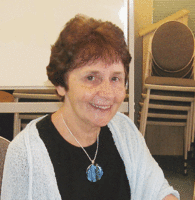Reflect
Veronica M Lawson RSM
3 July 2012
Mark 5:21-43
 In Mark’s gospel, we often find a story within a story. Some scholars refer to this technique as the making of a Markan sandwich, others as a framing device.
In Mark’s gospel, we often find a story within a story. Some scholars refer to this technique as the making of a Markan sandwich, others as a framing device.
In Mark 5:21-43, the frame consists of the two-part story of the desperately ill 12-year-old daughter of Jairus, a synagogue official. Jairus falls at the feet of Jesus in an attitude of reverence and pleads with him to come and lay hands on her.
Jesus is clearly known as a healer, one who can ‘save’ life. The passage closes with the young woman’s seeming death and restoration to life.
In between, we have the story of an older woman, also seriously ill, possibly with a gynaecological problem: she has been haemorrhaging for 12 years.
The stories are linked in many ways, first by the repetition of the number 12 – a symbolic number in a Jewish context.
Both the young Jewish girl and the older Jewish woman are in need of the saving power of God mediated through Jesus the healer.
Later in the Markan story [7:24-30) a Gentile mother and daughter will beg for and receive that same saving power of God.
Jairus’ daughter does not speak for herself. Like all young women of that culture, ill or not, she is dependent on the voice of her father.
The older woman comes tentatively ‘from behind’. She speaks, but only to herself as she touches Jesus’ cloak and experiences healing in her body. She is finally shamed into telling all.
Like Jairus, she falls at the feet of Jesus. Jairus refers to his little girl on the brink of adulthood as ‘my daughter’. Jesus addresses the older woman as ‘my daughter’.
Both women, the younger and the older, are daughters of Israel. Both are restored to health, one on account of her parents’ faith (the unnamed mother and the named father), the other because of her own faith.
Jesus the healer has embraced and responded to the pain of a woman alone on the one hand and of a family (mother, father and daughter) on the other.
Towards the end of the gospel (14:3-9), this Jesus who has brought healing to little children, to older women and younger women, to older men and younger men, to Jews and to Gentiles, will himself become the recipient of the healing ministry of an insightful woman who pours out healing ointment.
He will recognise this action as a beautiful thing that she has done ‘in him’.
For now, the stories recount ‘the beautiful thing’ he does in the lives of suffering humanity, irrespective of age or gender or status or ethnicity.